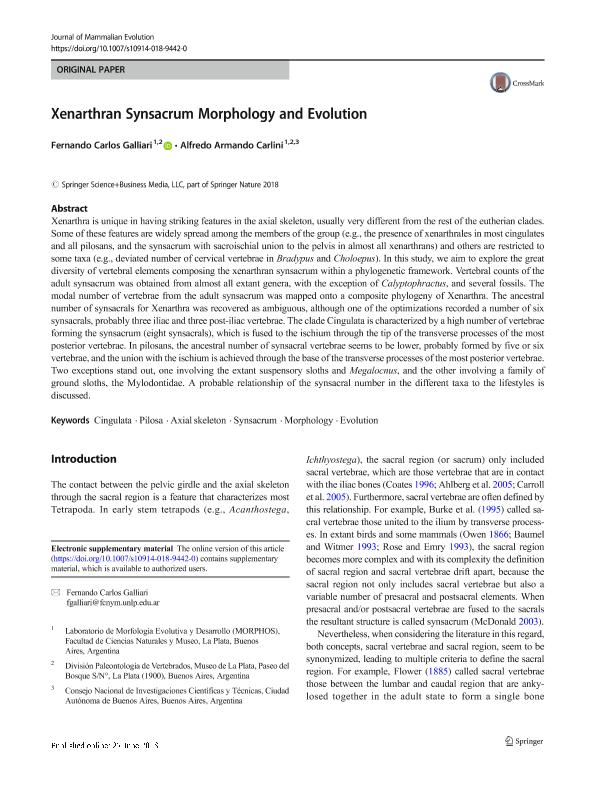Mostrar el registro sencillo del ítem
dc.contributor.author
Galliari, Fernando Carlos

dc.contributor.author
Carlini, Alfredo Armando

dc.date.available
2021-04-29T12:13:55Z
dc.date.issued
2019-12
dc.identifier.citation
Galliari, Fernando Carlos; Carlini, Alfredo Armando; Xenarthran synsacrum morphology and evolution; Springer; Journal of Mammalian Evolution; 26; 4; 12-2019; 493-504
dc.identifier.issn
1064-7554
dc.identifier.uri
http://hdl.handle.net/11336/131000
dc.description.abstract
Xenarthra is unique in having striking features in the axial skeleton, usually very different from the rest of the eutherian clades. Some of these features are widely spread among the members of the group (e.g., the presence of xenarthrales in most cingulates and all pilosans, and the synsacrum with sacroischial union to the pelvis in almost all xenarthrans) and others are restricted to some taxa (e.g., deviated number of cervical vertebrae in Bradypus and Choloepus). In this study, we aim to explore the great diversity of vertebral elements composing the xenarthran synsacrum within a phylogenetic framework. Vertebral counts of the adult synsacrum was obtained from almost all extant genera, with the exception of Calyptophractus, and several fossils. The modal number of vertebrae from the adult synsacrum was mapped onto a composite phylogeny of Xenarthra. The ancestral number of synsacrals for Xenarthra was recovered as ambiguous, although one of the optimizations recorded a number of six synsacrals, probably three iliac and three post-iliac vertebrae. The clade Cingulata is characterized by a high number of vertebrae forming the synsacrum (eight synsacrals), which is fused to the ischium through the tip of the transverse processes of the most posterior vertebrae. In pilosans, the ancestral number of synsacral vertebrae seems to be lower, probably formed by five or six vertebrae, and the union with the ischium is achieved through the base of the transverse processes of the most posterior vertebrae. Two exceptions stand out, one involving the extant suspensory sloths and Megalocnus, and the other involving a family of ground sloths, the Mylodontidae. A probable relationship of the synsacral number in the different taxa to the lifestyles is discussed.
dc.format
application/pdf
dc.language.iso
eng
dc.publisher
Springer

dc.rights
info:eu-repo/semantics/openAccess
dc.rights.uri
https://creativecommons.org/licenses/by-nc-sa/2.5/ar/
dc.subject
AXIAL SKELETON
dc.subject
CINGULATA
dc.subject
EVOLUTION
dc.subject
MORPHOLOGY
dc.subject
PILOSA
dc.subject
SYNSACRUM
dc.subject.classification
Zoología, Ornitología, Entomología, Etología

dc.subject.classification
Ciencias Biológicas

dc.subject.classification
CIENCIAS NATURALES Y EXACTAS

dc.title
Xenarthran synsacrum morphology and evolution
dc.type
info:eu-repo/semantics/article
dc.type
info:ar-repo/semantics/artículo
dc.type
info:eu-repo/semantics/publishedVersion
dc.date.updated
2021-04-28T20:09:35Z
dc.journal.volume
26
dc.journal.number
4
dc.journal.pagination
493-504
dc.journal.pais
Alemania

dc.description.fil
Fil: Galliari, Fernando Carlos. Universidad Nacional de La Plata. Facultad de Ciencias Naturales y Museo. División Paleontología Vertebrados; Argentina. Consejo Nacional de Investigaciones Científicas y Técnicas. Centro Científico Tecnológico Conicet - La Plata; Argentina. Universidad Nacional de la Plata. Facultad de Cs.naturales y Museo. Laboratorio de Morfologia Evolutiva y Desarrollo.; Argentina
dc.description.fil
Fil: Carlini, Alfredo Armando. Universidad Nacional de La Plata. Facultad de Ciencias Naturales y Museo. División Paleontología Vertebrados; Argentina. Universidad Nacional de la Plata. Facultad de Cs.naturales y Museo. Laboratorio de Morfologia Evolutiva y Desarrollo.; Argentina. Consejo Nacional de Investigaciones Científicas y Técnicas. Centro Científico Tecnológico Conicet - La Plata; Argentina
dc.journal.title
Journal of Mammalian Evolution

dc.relation.alternativeid
info:eu-repo/semantics/altIdentifier/url/http://link.springer.com/10.1007/s10914-018-9442-0
dc.relation.alternativeid
info:eu-repo/semantics/altIdentifier/doi/http://dx.doi.org/10.1007/s10914-018-9442-0
Archivos asociados
